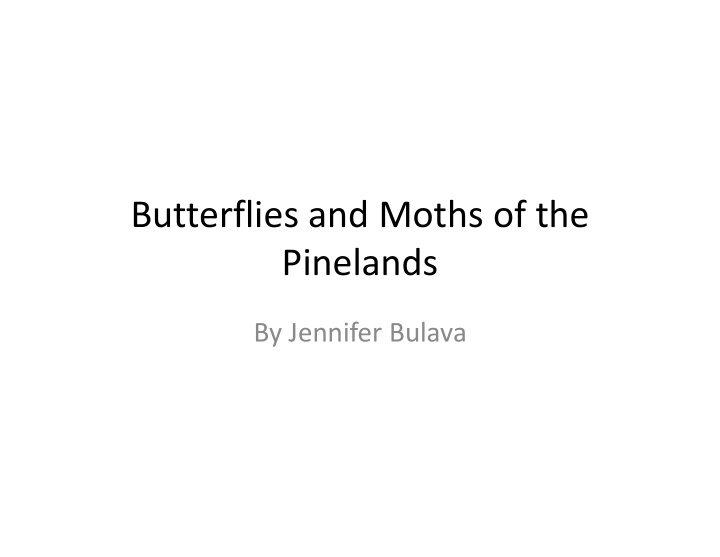



Butterflies and Moths of the Pinelands By Jennifer Bulava
Butterflies and Moths • Kingdom: Animals – Phylum: Invertebrates • Class: Insects – Order: Lepidoptera • Lepidoptera means « scale wing » in Greek • 4 wings covered by overlapping scales • Found anywhere where land plants grow, most abundant in tropics • 90% of lepidoptera species are moths (150,000 species out of 165,000 world ‐ wide) • Over 12,000 species in North America (725 butterflies)
Butterflies Moths • Diurnal • Generally nocturnal • Antenna are clubbed • Antenna are feathered • Chrysalis (naked pupa) • Cocoon (pupa inside) Skippers • Construct loose cocoons • Hold their wings at different angles (at rest) • Swift flight with little fluttering
Butterfly Life Cycle Larval Stage: Caterpillar – Plant eating machines (1000x weight) – 3 pairs of true legs and several false legs – Pair of jaws for slicing through plants – Simple eyes – Primarily feed on a specific host plant (adult lays her eggs on this plant)
Butterfly Life Cycle • Adults – Mostly drink flower nectar through a long proboscis • These are pollinators of plants – Some woodland butterflies feed on tree sap, rotting fruit, dung, carrion • These are recyclers of nutrients and waste – Compound eyes – Antennae packed with nerve endings sensitive to airborne chemicals
Butterfly Behavior • Taste with their feet • Puddling: when butterflies land on sand, mud, etc. to take up water and minerals dissolved in it, especially when it is hot and sunny. – Salt is difficult to find in plant nectar, & also why they land on your sweaty hand.
Butterfly Behavior Heat regulation • Bask in sun with wings open to warm themselves (flight muscles need to warm to ~ 85°F, why most butterflies are not out on cloudy days) • Can reposition their wings to minimize exposure • Those with dark undersides of wings will close them and then turn them to face the sun to warm up
Butterfly & Moth Defenses • Some are camouflaged (mourning cloak, comma, question mark, most moths) • Some are poisonous (monarch) • Some have patterns that mimic species that are poisonous (viceroy) • Some have eyespots that make it look like a large animal to frighten off predators (wood nymph)
Butterfly Behavior Territorial Defenses • Males defend locations frequented by females • Some patrol the same paths • Ascending flight (spiral) Hilltopping • Widely dispersed, low density, or limited vision • Instinctively fly to local high points to find mates
Butterfly Behavior Mating • Last segment of male’s abdomen has clasping mechanism to lock onto female • Female’s abdomen contains a retracting ovipositor
Skippers • Construct loose cocoons • Hold their wings at different angles (at rest) • Swift flight with little fluttering • Most are brown or pale orange
Moths • Most construct cocoons consisting of plant materials mixed with saliva • Rely on their sense of smell more than sight, for flying in the dark • Moths fly to artificial lights because they are confused or dazzled by the bright light
Attracting Butterflies & Butterfly Gardens • Mix of annuals and perennials • As many native species as possible • Should include host plants as well as flowers for nectar • Full sun
Conclusion • Butterflies & Moths = Lepidoptera • Adults are pollinators or recyclers of nutrients/waste • Complete metamorphosis – Egg, larva, pupa, adult • Can reposition themselves to regulate heat • Territorial Defenses (Patrolling & ascending flight) • Migratory status:10 species in our area Cloudless Sulphur, Common Buckeye, Red Admiral, Monarch, Painted Lady, American Lady, Pipevine Swallowtail, Fiery Skipper, Long ‐ tailed Skipper, Sachem
Recommend
More recommend